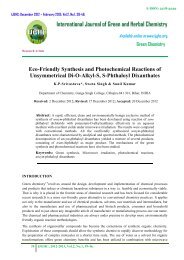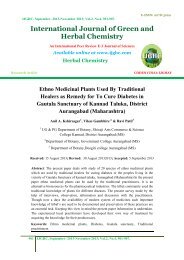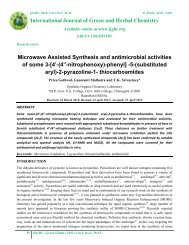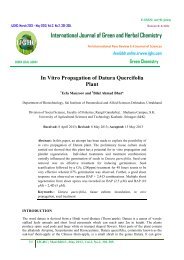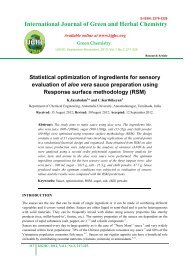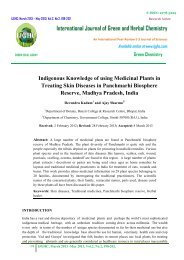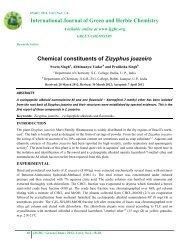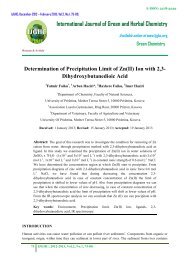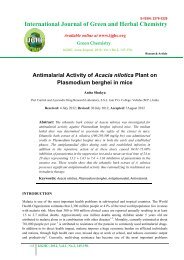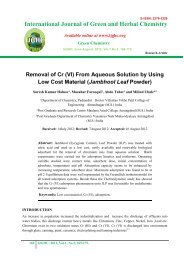Physicochemical Characterization, Chlorination and ... - IJGHC
Physicochemical Characterization, Chlorination and ... - IJGHC
Physicochemical Characterization, Chlorination and ... - IJGHC
You also want an ePaper? Increase the reach of your titles
YUMPU automatically turns print PDFs into web optimized ePapers that Google loves.
<strong>Physicochemical</strong>...Andzi et al.INTRODUCTIONThe water constitutes a more <strong>and</strong> more rare, vulnerable <strong>and</strong> with difficulty renewable foodstuff. Ofthis fact awareness imposes to manage it in a rational way <strong>and</strong> to worry about effects of the quality ofwaters on the ecosystems, but especially on the public health. It is thus important that water resourcesare effectively protected against any nuisance <strong>and</strong> that they are treated to produce water which thequality satisfies biological <strong>and</strong> physicochemical st<strong>and</strong>ards of drinkability.Our study is centred on the characterization of the specific problems of quality <strong>and</strong> treatment of thewater of river Djoue, mobilized for the production of the drinking water in Congo-Brazzaville.This water contains organic matters resulting from plant <strong>and</strong> animal life. This organic load isconstituted for the greater part, by humic substances 1 . Their presence in natural waters involvesnumerous problems, because they are responsible for the coloring of waters, for the complexation ofseveral toxic matters. Also, halogenated compounds may form by oxidation of these substances 2 .Various processes are used for the water treatment of surface, among which, the physicochemicalprocesses such as: the disinfection <strong>and</strong> the coagulation-flocculation.Disinfection of drinking water can be regarded as the most significant public health measure takenduring this century 3 . Destroying pathogens form drinking water has dramatically reduced theincidence of water-n transmitted diseases in all industrialized countries 4 . Over the past century,chlorination in the form of hypochlorous acid has become the most common method of disinfectingwater 5 . This use has come about because of chlorine powerful disinfecting capabilities against bothbacteria <strong>and</strong> viruses, it’s easy application <strong>and</strong> low cost 6-10 . Chlorine can be supplied as calciumhypochlorite (Ca(ClO) 2 ). Under alkaline conditions (pH > 7.5) the disinfectant capability of dissolvedhypochlorite is limited. On the other h<strong>and</strong>, at low to moderate acidities (pH < 7.5) the salt exist mainlyas hypochlorous acid (HOCl), which is about on thous<strong>and</strong> times more effective as a disinfectant thancompletely dissociated hypochlorite ion 11,12 . The major part of water chlorine dem<strong>and</strong> is due tooxidation processes 13 . However, the possible substitution of hydrogens in the molecules leads toformation of halogenated compounds by reaction of the oxidation on both the organic <strong>and</strong> inorganicmater of the treated water 14,-16 .The principle of the flocculation-coagulation is based on the destabilization of particles in suspensionby the injection <strong>and</strong> the fast dispersal of chemicals compounds (coagulant) to favor theirconglomeration <strong>and</strong> allow their decantation. The most difficult particles to eliminate in waters are theones which possess a very small size (colloidal particles responsible for the turbidity) <strong>and</strong> those whichare dissolved (organic matters responsible of the tint). These colloids usually carry a negative electriccharge which prevents the particles to agglomerate the some in the others to form more voluminousparticles (plop) <strong>and</strong> facilitate their elimination by sedimentation <strong>and</strong> filtration.The aim of the coagulation-flocculation is to neutralize the negative charge of these particles to favorthe formation of agglomerate. To do it, we usually introduce in the water the coagulant, mostly iron oraluminum salts. Mechanisms driving to the destabilization of colloids were widely studied 17-20 <strong>and</strong> canbe recapitulated as follows: the neutralization of charges relaying on the sufficient addition of cationsto neutralize the stable negative charge of particles. This mechanism meets only in acid pH (pH value< 5.5). In this case, the dominant species of the coagulant are positively charged (Al (OH) 2+ , Al(OH) 2+or Al 2 (OH) 2 4+ ). On the other h<strong>and</strong>, the overdose of coagulant, source of cations can cause a tooimportant adsorption of cations <strong>and</strong> invert the charge of particles which becomes positive. Theparticles would so be restabilized 21 . The imprisonment <strong>and</strong> the adsorption of colloids on aluminumplops are made when sufficiencies of Al 2 (SO 4 ) 3 , 18H 2 O) are added. In return, when pH valueincluded between 5 <strong>and</strong> 8, the coagulant is in the hydroxide of aluminum (Al (OH) 3 ) form 20 ,619 <strong>IJGHC</strong>; June – August 2013, Vol.2, No.3, 618-630.



